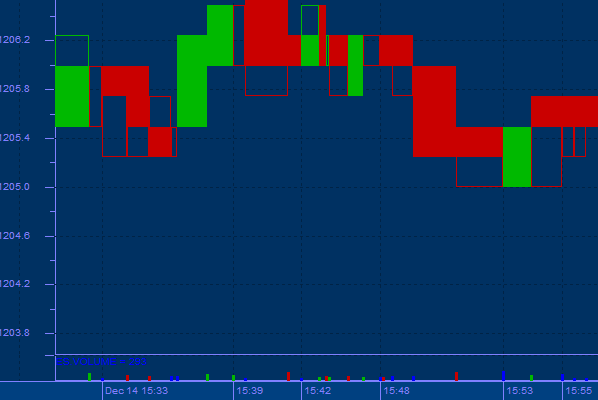Equivolume Shadow
Equivolume shadow displays prices in a manner that emphasizes the relationship between price, volume and the shadow (explained below). It measures the relationship between price and volume. Price is measured on the vertical axis and volume is measured on the horizontal axis.
Volume plays an important role in confirming price movements. It is sometimes difficult to track this relationship on a normal bar chart with volume plotted in a separate slot below. This is overcome by plotting price and volume activity on a single chart.
Equivolume combines price and volume in a two-dimensional box. The top line of the box is the high for the period and the bottom line is the low for the period. The width of the box is the unique feature of Equivolume, it represents the volume for the period. The shadow (empty region in the box) is based on the difference between open and either high or low depending on whether the price closed lower than the open of higher than the open for that interval bar. The bottom scale on an Equivolume shadow chart is based on volume. This suggests that volume is the guiding influence of price change. The equivolume shadow price style offers more information than the equivolume chart.
The height of each bar (or box) represents the trading range for the period – the highest and lowest prices recorded – while the width of the bar represents volume traded during the period.
You can tell a great deal about the commitment (The rate of withdrawal/entry in response to changing prices is referred to as the commitment of the party in control.) of buyers and sellers from the shape of the box.
An over square period shows that buyers and sellers are both strongly committed to their positions. This is a powerful reversal signal after a strong trend. Power periods show strong commitment by buyers in an up-trend (or sellers in a down-trend) and serve as confirmation of breakouts above resistance levels (or below support levels) in a chart pattern.
Usage
The shape of each Equivolume shadow box provides a picture of the supply and demand for the security during a specific trading period. Short and wide boxes (heavy volume accompanied with small changes in price) tend to occur at turning points, while tall and narrow boxes (light volume accompanied with large changes in price) are more likely to occur in established trends. Power box is one in which both height and width increase substantially. Power boxes provide excellent confirmation to a breakout. A narrow box, due to light volume, puts the validity of a breakout in question.
Volume & price are tied together allowing the trader to see what instrument is moving and the underlying pressure involve in its movement.
Instead of viewing volume as a secondary indicator at the bottom of a chart, volume is elevated to be as important as price. This encapsulates the essence of the Equivolume shadow chart, to view trades in price and volume of instrument traded rather than the price of those instrument alone.
The Equivolume shadow chart uses Volume during that interval to control the width of the candlestick body. The wicks are the same as a regular candlestick. Thus a fat candle means that the volume was high while a skinny one means that the volume was low. We know that low volume often means the movement does not confirm a price move as much as large volume. Thus with an Equivolume shadow chart we can see movements in the price that are very significant.
The basic interpretation of the Equivolume shadow chart is that short fat candles indicate a small change in price, but heavy volume. This has a tendency to occur at turning points. Tall and narrow candles indicate a small change in volume, but a large swing in price. This is seen often when prices are trending.

